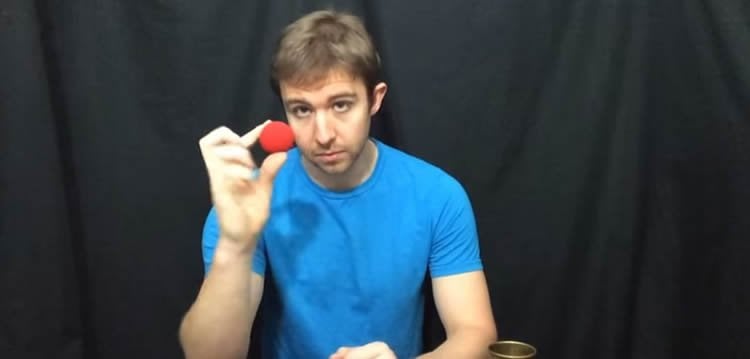Summary: Researchers set out to see if they can make people believe non-existent objects have disappeared.
Source: Oxford University.
Magicians use sleight of hand to confuse you about where an object is. But could they make you believe that you saw a non-existent object disappear?
A team of experimental psychologists at Oxford University developed their own magic trick to find out. Their results are published in the journal Frontiers in Psychology.
Matthew Tompkins led the study. He explained: ‘The science of magic actually played a significant role in the development of Experimental Psychology; the founding fathers of psychology were keenly interested in understanding how magicians could manipulate people’s perceptions. Despite this initial interest, magic has been largely ignored by contemporary psychologists until relatively recently. Much of sleight of hand magic is about misdirecting people about the location of an object, and there is a growing body of psychological research about how magicians cause our minds to override the input of our senses.
‘We wanted to go further and see whether magicians’ misdirection techniques could be used to induce the misperception of ‘phantom’ objects – could a magician make us ‘see’ something that was never there.’
420 volunteers watched a series of five silent videos, each showing part of a magic act, and immediately afterwards were asked to describe what they had seen and rate how surprising, impossible and magical it had been.
In the first four videos the magician would do something with an object, with the third video deliberately showing a non-magical action to check that people could distinguish whether something was or was not a magic trick and were not seeing a trick simply because they expected one. The first, second and fourth videos showed magic tricks.

The volunteers were split into five groups, each of which saw a series of video with a different object – a coin, a ball, a poker chip, a silk handkerchief or a crayon.
In the fifth video, the magician mimed making an object disappear. However, no object was ever shown in that video.
Nevertheless, 32% of people were convinced they had seen something disappear, with 11% of them naming the non-existent object. When asked to rate the trick, those who had not reported an object gave low scores for surprise, impossibility and magic; those who believed they had seen something gave higher scores, and those who could name the object gave the highest scores.
Matthew said: ‘We think what may be happening is that people are effectively confusing their expectations with a true sensory experience. They expect to see another video with a crayon or a coin, for example, and this expectation is so vivid that it can actually be mistaken for a real object.
‘The science of magic is a fascinating area, and there are important practical applications. For example, our work builds upon previous studies that have shown how eyewitness testimony can vary from the facts. In understanding how people can be fooled, we can gain better understanding of how our minds construct our conscious experiences.’
Source: Oxford University
Image Source: This NeuroscienceNews.com image is credited to Matthew Tompkins.
Video Source: The video playlist is credited to Matthew Tompkins.
Original Research: Full open access research for “The Phantom Vanish Magic Trick: Investigating the Disappearance of a Non-existent Object in a Dynamic Scene” by Matthew L. Tompkins, Andy T. Woods and Anne M. Aimola Davies in Frontiers in Psychology. Published online July 21 2016 doi:10.3389/fpsyg.2016.00950
[cbtabs][cbtab title=”MLA”]Oxford University. “Psychologist’s Magic Makes a Non-Existent Object Disappear.” NeuroscienceNews. NeuroscienceNews, 9 August 2016.
<https://neurosciencenews.com/psychology-magic-neuroscience-4810/>.[/cbtab][cbtab title=”APA”]Oxford University. (2016, August 9). Psychologist’s Magic Makes a Non-Existent Object Disappear. NeuroscienceNews. Retrieved August 9, 2016 from https://neurosciencenews.com/psychology-magic-neuroscience-4810/[/cbtab][cbtab title=”Chicago”]Oxford University. “Psychologist’s Magic Makes a Non-Existent Object Disappear.” https://neurosciencenews.com/psychology-magic-neuroscience-4810/ (accessed August 9, 2016).[/cbtab][/cbtabs]
Abstract
The Phantom Vanish Magic Trick: Investigating the Disappearance of a Non-existent Object in a Dynamic Scene
Drawing inspiration from sleight-of-hand magic tricks, we developed an experimental paradigm to investigate whether magicians’ misdirection techniques could be used to induce the misperception of “phantom” objects. While previous experiments investigating sleight-of-hand magic tricks have focused on creating false assumptions about the movement of an object in a scene, our experiment investigated creating false assumptions about the presence of an object in a scene. Participants watched a sequence of silent videos depicting a magician performing with a single object. Following each video, participants were asked to write a description of the events in the video. In the final video, participants watched the Phantom Vanish Magic Trick, a novel magic trick developed for this experiment, in which the magician pantomimed the actions of presenting an object and then making it magically disappear. No object was presented during the final video. The silent videos precluded the use of false verbal suggestions, and participants were not asked leading questions about the objects. Nevertheless, 32% of participants reported having visual impressions of non-existent objects. These findings support an inferential model of perception, wherein top-down expectations can be manipulated by the magician to generate vivid illusory experiences, even in the absence of corresponding bottom-up information.
“The Phantom Vanish Magic Trick: Investigating the Disappearance of a Non-existent Object in a Dynamic Scene” by Matthew L. Tompkins, Andy T. Woods and Anne M. Aimola Davies in Frontiers in Psychology. Published online July 21 2016 doi:10.3389/fpsyg.2016.00950







